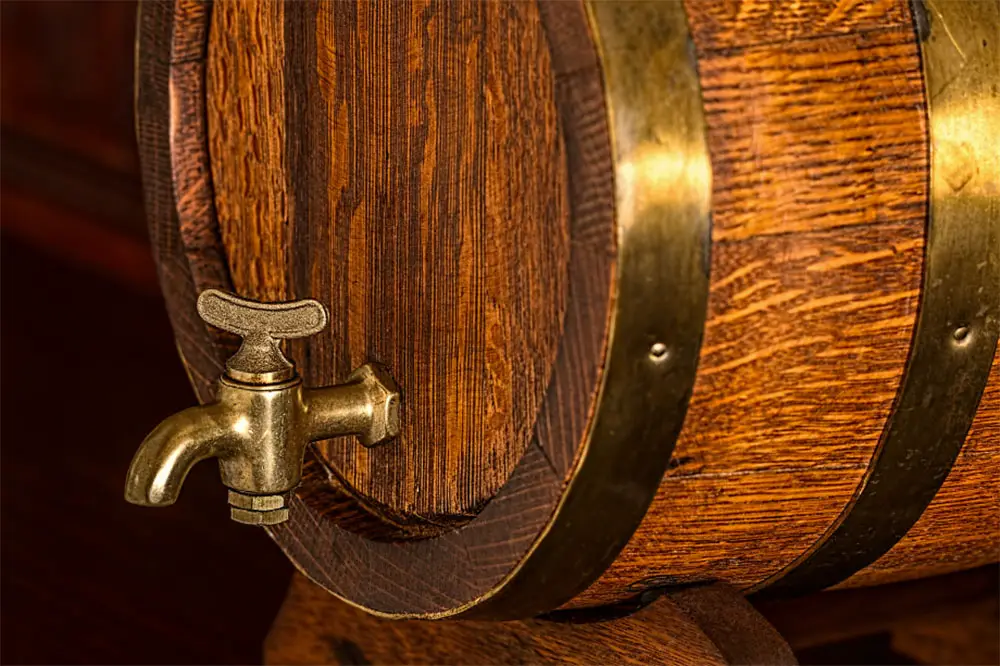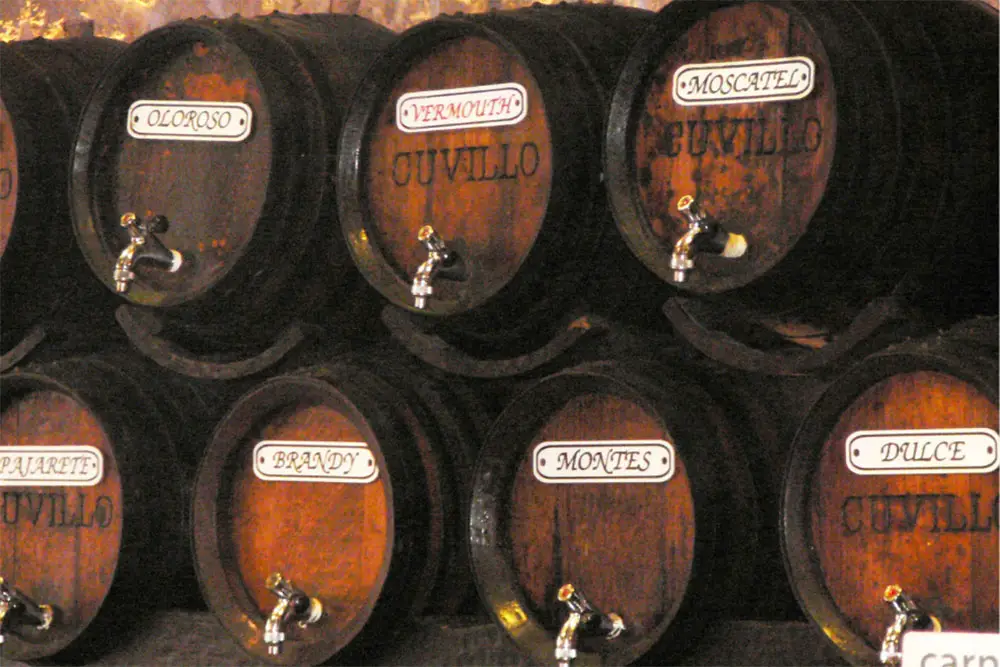Have you ever been to a brewery or distillery? You sign up for the tour expecting a fairly dull experience, thinking hey…at least I’ll get a few drinks to liven it up.
But the reality is, as soon as you’re taken through that staff-only door, you’re struck by a mesmerizing sprawl of gleaming, Wonka-esque contraptions, each with science-y yet whimsical names.

BEER DROP: Boxes of beer from Award-winning microbreweries → Join The Club
You half expect the workers to break out into song à la the Umpa-Lumpas, but it’s fine that they don’t because all the marvelous words you’re introduced to are like music to the ears anyway…words like “Firkin”.
Fun off the tongue and interesting in the ear, Firkin is a fantastic word, but what does it actually mean? Well, it all has to do with how beer is crafted. Intrigued? Fantastic; let’s press on.
Firkins – What Are They, and What Are They Used For?
There’s some fairly complicated equipment in a brewery, but luckily for us, a Firkin isn’t one of them, so it’s easy to explain and a total breeze to understand.
A Firkin is simply a beer cask, but not just any beer cask. This playful sounding word refers to a specific size of beer cask, a 10.8-gallon cask (1/4) to be precise, and while this particular size is rather special, it’s not the only one with its own name.
On your tour of the brewery, you’ll no doubt encounter the Pin cask, which is a smaller variant with half the capacity of a full-blown Firkin. Then, of course, there’s the infamous Kilderkin, which, at 21.6 gallons, has twice the capacity of the Firkin. Lined up, these cakes resemble a set of boozy Russian dolls.
Sometimes, the word Firkin is used interchangeably with the word cask, which has led to some confusion over the years, but if you want to get technical, it refers only to this one middle-sized variant.
Many breweries will still use some wooden casks, but these days, they’re mostly made out of metal. Traditionally, they were used to craft cask conditioned beer, but recently, they’ve been used for infusing beer with adventurous flavors too.
What Is Cask Conditioned Beer?
You know your average, everyday beer? It has its sudsy bubbles and a clear, golden hue. Well, that’s the exact opposite of craft conditioned beer, even though both types of drink are stored in casks.
Before it’s kegged, normal beer is filtered of any particulate content and carbonated, imbuing it with that signature fizz. To get it out of the keg for a good old knees-up, it has to be pushed out by CO2 or nitrogen. The pressure allows it to be pumped up through the lines to the taps at your favorite bar.
Cask conditioned beer, on the other hand, is neither filtered nor carbonated. In fact, the fermentation process hasn’t even completed when the beer is decanted into the Firkin, allowing it to strengthen as it idles.
The beer aficionados out there will already know that as the yeast absorbs the digestible sugars in the fermentation process, one of the byproducts is CO2, which is why a cask conditioned beer will still have a few bubbles floating to the surface. However, as it’s not filtered, it will have a mildly cloudy appearance.
The traditional, not to mention best, way of serving conditioned beer is via a beer engine, which I know sounds like an awesome train, but it’s actually just a specialized hand pump system.
Alternatively, a cask tap is hammered into the top side of the Firkin, allowing gravity to do its work and let the beer flow, but be warned, depending on the pressure within the Firkin, this method can be messy, so prepare yourself for a beer shower.
For the optimal pint of conditioned beer, the cask needs to be kept at no higher than 55° F, which is why traditional bars around the globe will store them in the basement.
So, to sum up, the kegging of normal beer is a simple storage technique, while the casking of conditioned beer is part of the crafting process. It allows brewers to create truly unique drinks capable of enticing thirsty bar patrons looking for something a little bit different on their afternoon out.
Why Are Firkins Used?
Historically, casks were the only method of storing and transporting beer, as we didn’t have any of the fancy tapping systems that we do now, but there are a few good reasons why the Firkin is still used today.
The most important reason for the Firkin’s relevance in the modern age is that they can be used to make unique drinks. Omitting the filtration and carbonation from the brewing process, you’re often left with a stronger, smoother, richer beer.

Much like red wine, conditioned beers benefit from a higher serving temperature, as it can enhance the aroma and flavor profile, whereas standard beer should be served ice-cold and crisp like white wine.
Another reason the humble Firkin has avoided the trash heap is that they can be used to create infused beers, by which I mean a beer with experimental flavorings.
This is done by placing something flavorful inside the Firkin with the beer — think fruits, herbs, and peppers…even marijuana if that’s what floats your boat. But there is an important distinction to be made between conditioned and infused beer.
When infusing, brewers will typically use a finished beer rather than one that’s still in the throes of the fermenting process. You’ll often see this kind of beer at brewery kiosks at special events such as beer festivals, as they’re a great way to catch the eyes of wanderers and draw them in for a taste.
The Pitfalls of Misunderstanding Cask Conditioned Beer
If you don’t know what a conditioned beer is before ordering one, you’re sure to get a shock. There’s you expecting a cold, crisp, refreshing pint of normal beer, when all of a sudden, the bartender hands you over a cloudy, warmish, flat glass of the good stuff.
Without prior knowledge of what was coming your way, you’re sure to be disappointed, and if you’re a particularly confrontational person, you may even kick up a fuss at the bar and make a scene.
Without the bubbles you normally associate with beer, it’s understandable that you’d think it was old. That’s certainly the case if your Coca-Cola goes flat, right? But in this instance, it’s entirely intentional and an essential part of the drink’s character.
The comparative warmth of conditioned beer might also lead you to believe it’s stored in subpar conditions, and once you start throwing those accusations around, you better find yourself a new local watering hole, because the owners will not tolerate slander.
You may even think the unique, rich flavor of cask conditioned beer is down to spoiling, and while it’s true that cask conditioned beer does go bad faster than standard beer, a bar won’t sell it after the fact. The experienced drinker would taste it in the very first sip.
Furthermore, conditioned beer sells like hotcakes, so it’s very rare that a bar will have any left to spoil. People love to try something different when they hit the town for a drink, so they’ll automatically gravitate towards the conditioned beer.
I personally will actively seek out bars that offer a good selection of constantly changing conditioned beers, so I can perpetually try new flavors and keep my drinking experience fresh, exciting, and enjoyable.
And, once again, the bar owners aren’t going to take kindly to your inferring that they’re pedaling gone off drinks, so you’ll be out on your ear before you can say “there’s a gherkin lurkin’ in the Firkin”.
Of course, any bar staff worth their salt will always try to educate customers about the drinks as they choose, but if it’s particularly busy or the customer has already decided, they’re not going to be able to provide the usual lecture.
That’s why it’s important that, as a patron, you clue yourself up on the basic distinctions between standard, conditioned, and infused beers before hitting the bar. If there’s a tap, read the label for clues as to what might come out, and If you’ve got signal, it’s also a good idea to Google the brewery and beer names for more information.
Final Thoughts
Beer is over 3900 years old, and it really hasn’t changed all that much since then, but the innovation of craft breweries is keeping the art of brewing alive. They’re using traditional equipment such as the Firkin to reinvent everybody’s favorite weekend drink on a constant basis.
Inspired by drinking of the past, they’re able to influence drinking of the future, and they’re absolutely killing it! Their marvelous creations have become total bar-fillers, bringing in all sorts of customers that are, well…bored of sipping the same old drinks time and time again.
The popularity of these bespoke beverages is why more and more we’re seeing bars advertising, cask-based events, with posters reading something along the lines of “It’s the Firkin Wirkend”, “Cask and You Shall Receive”, or for owners lacking a penchant for puns, simply “Real Ale Wednesdays”.
That said, conditioned beers aren’t for everyone, and that’s totally fine. They’re completely dissimilar to your average carbonated, store-bought beer. If you enjoy the refreshing, fizzy finish of that kind of drink, real ale is going to be a shock to the system to say the least.
Even though infused beers are technically finished before the flavorings are added, they too can be unappealing to the lover of bog-standard beer. They’re not the best choice if you plan on drinking a lot, as the strong flavors can become quite overpowering by the third or fourth glass. They’re best to be sipped and savored over long periods of time.
Infused beers are far more prominent in the U.S. than cask conditioned beers, so my one piece of advice before we part ways is that if you come across a bar tapping a Firkin, give the nectar within a try. You may absolutely hate it, but shy of planning a trip to Europe, you may never get another opportunity to taste one.
Will You Enjoy Drinking Beer From a Firkin?
